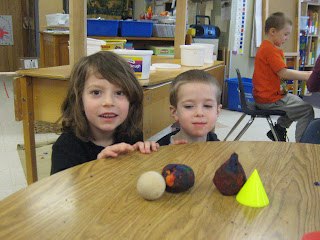We are studying shapes, including properties of 2-D and 3-D shapes. Children have been making circles and spheres, squares and square prisms, rectangles and rectangular prisms, etc. We took a shape walk around the building and made a shape poster of all the cones, pyramids, cylinders, and prisms we found around the building. We have built these shapes with playdough, comparing wooden or colored blocks to what we are building.
We have made two dimensional shapes on geoboards using rubber bands. We made a shape book in the format of "a square is a square until you add a roof and a chimney, and then it's a house." We followed this up with a mural we made of a ski slope, using shapes to fill in the skiers and the parts of the ski mountain. We have also filled in puzzles trying out assortments of pattern blocks that can all be used to fill the same shape. Another example of this is Fill the Hexagon in which children find as many different ways as possible to make a hexagon.
An offshoot of this study of shapes is a renewed interest in building elaborate block structures. The most challenging activity we have done is to build structures out of snap cubes. Children are asked to duplicate three-dimensional structures, learning to count cubes, telling themselves whether to put more cubes on this side or that side as they figure out how to describe the structure to themselves. .
Thursday, March 21, 2013
Our Bodies
We began work on our brains and nervous system a month ago. We have since added our digestive system, including intestines, and our lungs. The pictures show children making their spines and measuring out the length of their intestines, 30 feet on average. We do a lot of writing about our bodies in language arts, after reading about the system and then making a poster about the concepts we have learned. When children write in their own book, they refer to the poster, as well as consulting books about what they are studying.
The Fix-It Shop
We have been having a great time in our fix-it shop. We started by taking apart a typewriter, finding many parts that we never expected. The hardest part is those stubborn screws that are buried deeply inside the appliances. It takes muscle power! We have moved onto taking apart a vacuum, a pencil sharpener and a fan.
Subscribe to:
Posts (Atom)
























